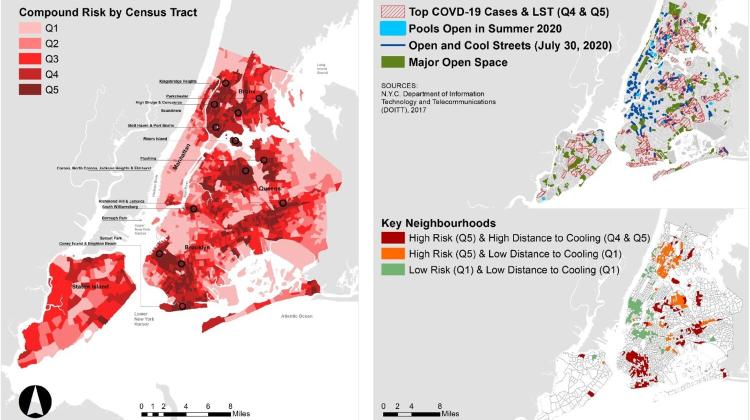Designing Better Public Health Interventions

Compound Risk, Cooling Interventions, and Key Neighborhood Observations. Credit: Research Team
How did health risks associated with acute climate crisis events interact with the global COVID-19 pandemic? More broadly, which populations are most at risk from the negative externalities of public health emergency compounded climate crisis impacts and how might understanding who these vulnerable populations are suggest for designing interventions to shelter them?
Utilizing data collected in New York City from 2020 through 2022, a team of MIT, Columbia, Pratt Institute, and City Tech researchers mapped the geographies of exposure and interventions to identify risk landscapes to understand if the same communities most at risk during extreme heat events also shared outsized risk from the pandemic waves of infection. By leveraging various streams and types of data, the team created a compound risk index that combines heat, COVID-19, density and social vulnerability from factor analysis of natural environment characteristics, built and social environmental characteristics and social factors.
“Our analysis of heat waves and COVID-19 identifies places of highest risk and shows the ways multiple hazards impact general social vulnerabilities that are also tied to place,” said Janelle Knox-Hayes, a member of the research team. “Specifically, social, environmental and built structural factors interact and overlap in specific places. The findings from our research demonstrate that the compound risks of COVID-19 and heat stress are both public health and equity challenges.”
The findings from the research team are available via a new paper in Local Environment: The International Journal of Justice and Sustainability, titled: “The compound risk of heat and COVID-19 in New York City: riskscapes, physical and social factors, and interventions.” The research team led by Knox-Hayes includes: DUSP’s Juan Camilo Osorio (PhD ’23 and Assistant Professor at Pratt Institute's Graduate Center for Planning and the Environment) and Rose Winer-Chan (MCP ‘23); DUSP alumnae Natasha Stamler (SB ‘22) and Mary Hannah Smith (MCP ‘20); Columbia University’s Maria Dombrov and Cynthia Rosenzweig; and New York City College of Technology’s Reginald Blake.
“Our findings demonstrate the way compound risks affect communities living in vulnerable conditions in dense cities, where these risks can be neither understood nor addressed in silos. To do so, we need to study the histories of disinvestment, neglect and segregation that have led to them. Strategies to reduce vulnerability must likewise address underlying ecological, physical and socio economic factors, particularly in low-income and communities of color that have suffered from historic disproportionate burdens,” said Osorio. “In order to fully understand compound risks we need to think more holistically and acknowledge the myriad social and socio-environmental determinants of public health – but to fully address them, we have to activate the technical, ethical and political dimensions of our work at the service of local grassroots leaders in their pursuit for environmental and climate justice.”


